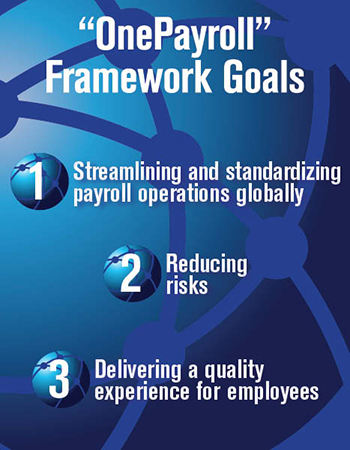 Complexity and fragmented processes once topped the list of issues facing Microsoft’s global payroll teams. We thought we could successfully address these issues while also improving the employee experience, but we knew it wouldn’t be easy.
Complexity and fragmented processes once topped the list of issues facing Microsoft’s global payroll teams. We thought we could successfully address these issues while also improving the employee experience, but we knew it wouldn’t be easy.
Further complicating the situation was the need to deal with multiple stakeholders. The only answer was to construct a standardized, yet flexible global solution.
Our team worked on a new approach and developed a “OnePayroll” framework with three high-level goals in mind:
- Streamlining and standardizing payroll operations globally
- Reducing risks
- Delivering a quality experience for employees
Microsoft is a complex, multinational company made up of more than 116,000 Microsoft employees with a central team, subsidiaries, and operation centers across Europe, the Middle East, Africa, Asia, the United States, and Latin America.
Its employees are in 108 countries and are spread across Microsoft business organizations such as:
- Productivity and business processes, comprised of commercial and consumer office, Office 365, Dynamics 365, and LinkedIn
- Intelligent Cloud, which includes our portfolio of server products, Azure services, and Enterprise services
- More personal computing that includes Windows, devices, search, and gaming
Streamlining, Standardizing Payroll Operations Globally
One of the first steps in kicking off the new initiative began about four years ago and involved consolidating more than 50 payroll providers down to three around the world. Our team worked with the three payroll providers to standardize their payroll processes and streamline their workflow.
We hired a global management consulting firm to manage payroll governance and data administration. By selecting a single global supplier for data administration and governance, we brought integrated implementation and operations oversight into our global payroll operations. The firm manages the metrics, governance, and employee queries, which are all raised in the same way through a single employee touchpoint for all payroll inquiries. The fact that the country or service provider may be different is irrelevant—everyone receives the same experience.
Implementing standard and streamlined payroll operations globally ensures payroll processes are consolidated, harmonized, and well-controlled. This also means that there is a greater flexibility to grow and to adapt to change. There is always a cost to payroll, but while it doesn't make money, it can save money. The goals to our change management initiatives are efficiency and effectiveness, so there isn't an increased dollar cost for resources every time something changes.
A Power BI (business intelligence) tool was developed that provides a consolidated dashboard of real-time service metrics to be used as a “scorecard.” We are leveraging this tool along with a global customer relationship management (CRM) centralized system for enhanced metrics reporting and communication. This provides greater end-to-end visibility focusing on key metrics and actionable data. This approach enables rigorous governance.
Reducing Risks
Global controls should provide consistent governance and compliance. Standardized controls and processes help mitigate risks.
The team established 25 global controls and seven key quality controls to improve transparency and consistency. A monthly controls monitoring program tracks the execution of these controls by all parties involved and reports the compliance performance for all countries.
As a result, there has been more visibility into payroll operations. In the past, if there was a risk to the business in a given country, there wouldn't necessarily have been an awareness of it at a global level. This is no longer the case. This model is replicable in nearly all countries, regardless of size, with a quality employee experience at the center of our mission. Each country works within one global model, which enables the local management and global leadership to work together to improve payroll performance.
An important aspect of any payroll-related transformation at the global level is a comprehensive planning exercise that defines the global processes for payroll in each country that would best support a successful transition. Global transformations carry inherent change management risks, demanding a phased approach. In this case, the transition was broken into waves over 2½ years, with a typical wave including more than 20 countries. With the knowledge gained during the first wave of 21 countries, additional measures aimed at increased visibility into payroll operations and performance began being implemented.
Delivering a Quality Experience for Employees
Having standardized ways of working, controls, and processes makes the employee experience simpler and easier. This is a big driver in enhancing employee satisfaction. Our commitment to quality employee experience is reflected by our team’s ticket response metrics being tracked by Power BI, which are reported on the daily dashboard. The team has significantly improved the employee experience by bringing down the average resolution time of all employee inquiries to less than two business days.
We are looking to further bring the benefits of payroll automation to deliver a quality employee experience. Our payroll team has already launched and deployed artificial intelligence technology—AI Intelligent Email Advisor—for the automatic conversion of emails into CRM tickets which will then be categorized by request category. This not only helps improve ticket response time but also saves the team’s manual efforts, thus enabling them to focus on value-added activities like providing quality responses to employees.
Another technology that has been launched and deployed is robotic process automation (RPA) that automates the core input payroll processing in our systems, helping to reduce the need for manual intervention to process payroll inputs. This brings improved data accuracy. We are leveraging RPA across all areas with tools for input reminder, payslip communication, entering data into the payroll interface system, and automated response resolution. This means better operational efficiency, which eventually results in employees enjoying a much simpler, improved experience.
At Microsoft, our global payroll team is presently:
- Providing a single, standard way to interact with payroll operations for more than 48,000 employees out of more than 116,000 Microsoft employees globally
- Functioning effectively in more than 100 countries by employing three main payroll providers
- Operating in 15 languages from four delivery centers across Mumbai, Dalian, Prague, and Buenos Aires
- Managing, on average, nearly 3,200 employee inquiries per month via a single employee platform—Global Payroll Services Portal, through which employees across the globe can submit, track, and escalate their queries
- Mitigating risk and providing better accountability to payroll operations globally
- Enabling every payroll administrator to work the same way regardless of location, language, and payroll provider
Rigorous attention to service level agreements and a mindful focus on the employee experience enables the team to apply valuable learning as each new country joins the program. This learning is exchanged in the teams’ internal meetings, and knowledge sharing is done from Assistant Payroll Consultants responsible for countries in various stages of transition. It's all about learning as you go.
Some valuable lessons for companies considering similar initiatives include the need to gain leadership buy-in, conduct rigorous knowledge transfer, maintain good relationships with upstream and downstream partners, be clear on outcomes, and communicate with all stakeholders regularly.
Do you like our content? Join the GPMI community to get free education and articles straight to your inbox!

Victor Garcia is Senior Director, Global Payroll at Microsoft, one of a number of key positions he has held at the firm since 2000. Currently, he oversees realignment of the payroll organization into a new global organization responsible for U.S. as well as the international payroll transformation program OnePayroll. He has earned Microsoft’s “Circle of Excellence” award, been recognized as “Best EMEA F&A Regional Controller,” and named “HR Superstar” by HRO Today in 2016.